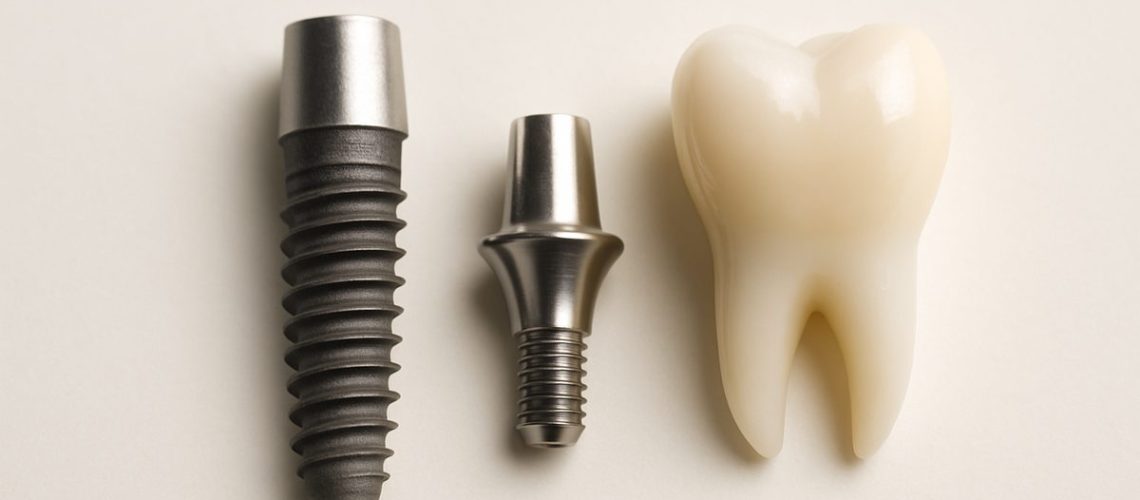If you’ve googled “what does tooth implant look like,” you’ll find a mix of X-rays, photos of gums healing, and finished teeth that blend with a smile. This piece explains the three main parts of an implant, how an implant appears at each stage, common restoration types, factors that change the look, what to expect during the procedure and recovery, and how an expert surgeon improves esthetic results.
What a Tooth Implant Is — The Three Main Parts
The implant post (root)
The implant post is a small metal or ceramic screw placed into the jawbone to act like a tooth root. Most posts are titanium or zirconia. On X-rays it looks like a tapered cylinder; in the mouth you won’t see it once the gum heals over.
The abutment (connector)
The abutment screws onto the implant post and connects the post to the crown. It peeks through the gum line and can be metal or tooth-colored. Its shape helps form the gum contour for a natural emergence profile.
The crown (the visible tooth)
The crown is the custom-made tooth you see. Crowns are usually porcelain or zirconia and are color-matched and shaped to blend with neighboring teeth. A well-made crown looks and functions like a natural tooth.
What Does a Tooth Implant Look Like at Each Stage?
Before treatment
Before treatment you’ll usually see a gap where the tooth used to be. Gums may be flat or sunken if the tooth has been missing a long time, which can affect the final esthetic.
Immediately after placement
Right after oral surgery expect swelling, sutures, and a small healing cap over the implant. It looks like typical oral surgery—bruising and puffiness are common for a few days.
During healing (osseointegration)
During bone healing the gum shapes around the abutment or healing cap. The implant is still not the final tooth, but the mouth starts to look more normal as swelling subsides and tissue matures.
Final restoration
When the final crown is placed, the tooth should match the shape, size, and color of adjacent teeth. Proper planning creates a seamless result that’s hard to distinguish from natural teeth.
Common Implant Restorations and Their Appearance
Single-tooth implant crown
One natural-looking tooth replaces a single gap and blends with the smile.
Implant-supported bridge
Two or more implants support several connected crowns, forming a continuous row of teeth where multiple teeth were missing.
Full-arch (All-on-4 / same-day) restorations
A full set of teeth is fixed to multiple implants. You may get a provisional acrylic set day one and a stronger zirconia or porcelain restoration later.
Zygomatic implants
For severely resorbed upper jaws, zygomatic implants anchor in cheekbone bone; the final appearance matches other full-arch solutions.
Factors That Change How an Implant Looks
Gum health and bone levels
Thicker gums and good bone create a natural emergence profile. Bone grafts or soft-tissue grafts may be needed to improve esthetics.
Crown material and color matching
Zirconia and porcelain differ in translucency and stain resistance. Skilled shade matching makes crowns appear more natural.
Implant position and prosthetic design
Careful 3D planning keeps implants hidden and crowns aligned for a balanced smile.
What to Expect During the Procedure and Recovery
Expect a consult with 3D imaging and sedation options, possible same-day provisional teeth for some cases, and a recovery period with swelling and a soft diet. Most patients receive the final crown after months of healing.
How to Tell an Implant From a Natural Tooth
Visual cues include subtle gum margins or color differences; implants lack root sensation. A dental X-ray or CBCT confirms an implant.
Why Choose a Board‑Certified Oral Surgeon for Implants
Board-certified oral surgeons have extra surgical training that reduces risk, manages complex bone or sinus needs, and improves esthetic outcomes.
Texas Center for Oral Surgery & Dental Implants in the Dallas–Fort Worth Metroplex is a family‑owned specialist practice with board‑certified oral and maxillofacial surgeons, an in‑house digital lab, and advanced tools like X‑Nav, CBCT, Trios scanners, zirconia milling, and 3D printers to create precise, natural‑looking restorations.
Bring your medical history, photos, and questions to a consult. If you want to see how a tooth implant will look for your smile, schedule an evaluation to review images, options, and a personalized treatment plan.

